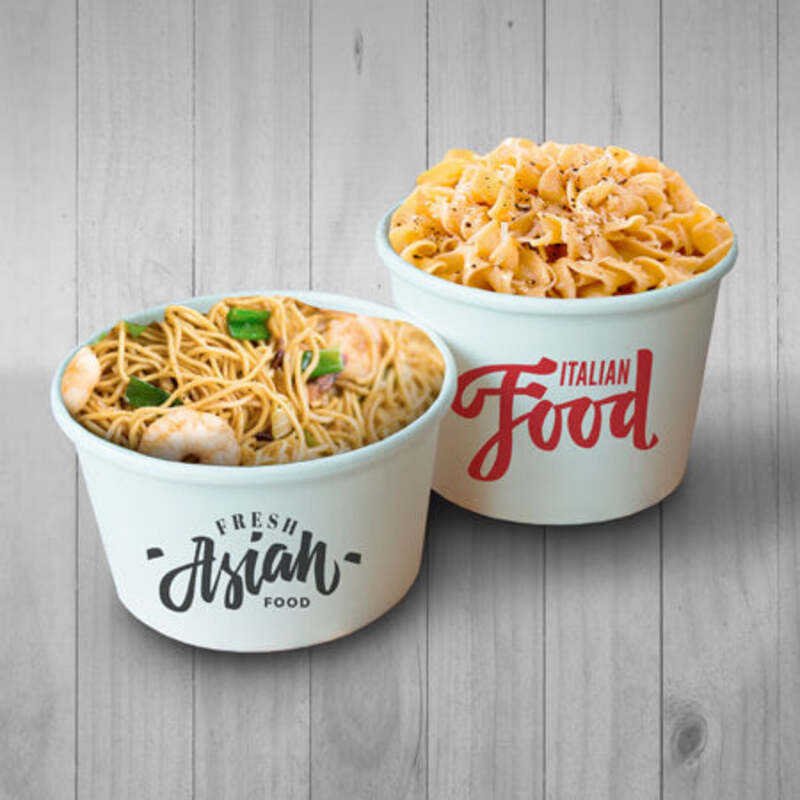Why Do We Package Food? A Comprehensive Insight into the Importance of Food Packaging
In a fast-paced world where convenience and safety are paramount, food packaging plays a vital role in our lives. We encounter packaged food products daily, from the breakfast cereal we pour into our bowls to the snacks we enjoy during breaks. But why do we package food, and what are the benefits of this practice? In this comprehensive article, we delve into the intriguing world of food packaging, exploring its significance, evolution, and impact on our daily lives. So, let’s unwrap the secrets behind why we package food!
Printed Food Container - 1 Colour Screen Print
Why Do We Package Food?
Packaging food serves multiple essential purposes, ranging from preservation and protection to consumer appeal and convenience. Here’s a closer look at the primary reasons why food packaging is a crucial aspect of modern living:
1. Preservation of Freshness
Food packaging helps to maintain the freshness and quality of perishable items by creating a barrier against external factors such as air, moisture, and light. It prevents spoilage, extends shelf life, and ensures that consumers receive products at their best.
2. Ensuring Food Safety
Proper food packaging helps to protect edibles from contamination, thereby reducing the risk of foodborne illnesses. Packaging acts as a reliable safeguard, preventing exposure to harmful bacteria, viruses, or chemicals.
3. Convenience and Portability
Convenience is paramount in today’s busy world. Packaging makes it easier to store, transport, and consume food products, making them ideal for on-the-go lifestyles.
4. Information and Labelling
Packaging provides essential information, such as nutritional content, ingredients, allergens, and preparation instructions. This empowers consumers to make informed choices about the products they purchase.
5. Brand Identity and Consumer Appeal
Eye-catching packaging designs and branding influence consumer choices. Attractive packaging can evoke emotions, create brand loyalty, and entice potential buyers.
6. Sustainability and Environmental Impact
With growing environmental concerns, sustainable packaging options are gaining prominence. Biodegradable and recyclable materials help reduce the environmental footprint of packaging.
The Evolution of Food Packaging
The history of food packaging is a fascinating journey that reflects the advancements in technology, consumer demands, and sustainability. Let’s explore the key milestones that have shaped food packaging over the years:
1. Natural Containers in Ancient Times
In ancient civilizations, people used natural materials like leaves, animal skins, and woven baskets to preserve and transport food.
2. Advent of Glass and Canning
The 19th century witnessed significant advancements with the introduction of glass containers and the canning process, revolutionizing food preservation.
3. Rise of Plastic Packaging
Plastic packaging gained popularity in the mid-20th century due to its versatility, affordability, and lightweight nature.
4. Tetra Pak and Aseptic Packaging
In the 1960s, Tetra Pak introduced aseptic packaging, enabling long shelf lives for perishable liquids without refrigeration.
5. Sustainable Packaging Innovations
Modern times have brought a strong focus on sustainable packaging materials, such as bioplastics, compostable packaging, and eco-friendly designs.
LSI Keywords in Food Packaging
To enhance our understanding, let’s explore some LSI (Latent Semantic Indexing) keywords associated with food packaging:
- Food packaging materials
- Importance of food packaging in the supply chain
- Innovations in food packaging technology
- Impact of packaging on food waste reduction
- Consumer preferences in packaging designs
- Food packaging regulations and standards
The Impact of Food Packaging on Daily Life
Food packaging profoundly influences our daily lives, from the moment we step into a grocery store to when we open a packet for a quick snack. Consider the following ways packaging affects us:
1. Convenience and Time Efficiency
Packaged foods offer ready-to-eat solutions that save time on meal preparation, catering to our busy schedules.
2. Food Safety and Hygiene
Sealed and tamper-proof packaging ensures that the products we consume are safe, hygienic, and free from contamination.
3. Extended Shelf Life
Packaging techniques like vacuum sealing and modified atmosphere packaging extend the shelf life of products, reducing food wastage.
4. On-The-Go Lifestyle
Individually packaged snacks and beverages are perfect companions for our on-the-go lifestyle, offering sustenance during commutes and travel.
5. Portion Control and Freshness
Single-serving packages and resealable bags help control portions and maintain freshness, preventing food spoilage.
6. Brand Recognition
Iconic packaging designs create a connection with consumers, contributing to brand recognition and loyalty.
FAQs about Food Packaging
Q: Are there any eco-friendly food packaging options available?
A: Yes, many eco-friendly options such as biodegradable materials, compostable packaging, and recyclable plastics are increasingly available, promoting sustainability.
Q: How does vacuum packaging work?
A: Vacuum packaging removes air from the package, preventing the growth of spoilage-causing bacteria and extending the product’s shelf life.
Q: Does packaging impact the taste of food?
A: In some cases, packaging materials can affect the taste of food. However, advancements in food-safe packaging have minimized this impact.
Q: What role does packaging play in reducing food waste?
A: Packaging plays a significant role in reducing food waste by protecting and preserving food, allowing it to reach consumers in optimal condition.
Q: How can consumers contribute to sustainable packaging practices?
A: Consumers can opt for products with eco-friendly packaging, practice proper recycling, and support companies that prioritize sustainability.
Q: How is technology influencing food packaging trends?
A: Technology has led to innovations like smart packaging, interactive labels, and QR codes, enabling better consumer engagement and product information.
Conclusion
Food packaging is not just about wrapping products; it’s an integral part of our modern lifestyle. From preserving freshness to ensuring safety and convenience, packaging plays a crucial role in delivering the products we love. As we move towards a more sustainable future, the evolution of packaging will continue, bringing eco-friendly solutions to reduce the environmental impact. So, the next time you reach for a packaged snack or meal, remember the incredible journey of food packaging and its significance in shaping our lives.





